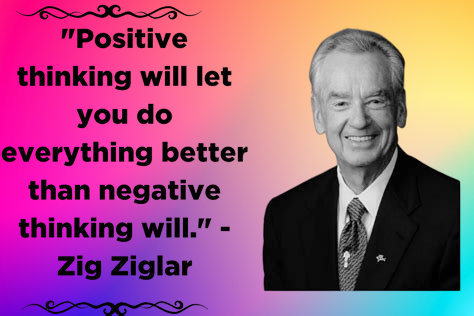Understanding Positive Thinking
Table of Contents
Positive thinking refers to the mental attitude of focusing on the favorable aspects of situations, challenges, and potential outcomes. It is grounded in the belief that challenges can be approached with a constructive mindset, ultimately leading to success and personal growth. While often conflated with mere optimism, positive thinking encompasses a deeper, mindset-focused approach. This involves a deliberate choice to perceive circumstances positively and to foster resilience against adversities.
The principles of positive thinking are rooted in cognitive-behavioral psychology, which posits that our thoughts significantly influence our emotions and behaviors. By adopting a positive mindset, individuals can cultivate an environment where constructive thoughts flourish, thereby enhancing both personal and professional experiences. Importantly, positive thinking does not imply ignoring reality or pretending challenges do not exist; rather, it emphasizes dealing with issues through a lens of possibility and hope.

A positive mindset encourages individuals to reframe negative thoughts and replace limiting beliefs with empowering affirmations. This approach is crucial in the workplace, where challenges such as tight deadlines, competition, and conflict can create stress. By embracing positive thinking, employees can develop resilience, adaptability, and enhanced problem-solving skills. For instance, when faced with criticism, a positive thinker might view it as an opportunity for improvement rather than a personal attack. In team settings, promoting positive thinking can lead to increased motivation, collaboration, and innovation among colleagues.
Moreover, positive thinking has proven relevance across various contexts, from leadership challenges to personal development initiatives. Leaders who embody positive thinking often inspire their teams, encourage open communication, and foster a culture of empowerment. By understanding and adopting a positive mindset, individuals can significantly enhance their professional trajectories and overall well-being.
The Connection Between Positive Thinking and Professional Success

Positive thinking plays a crucial role in fostering professional success, a concept supported by various research findings and real-world examples. Studies have shown that individuals with a positive mindset tend to perform better in their jobs, exhibit higher productivity, and experience improved interactions with colleagues and clients. This correlation is rooted in the ability of positive thinking to enhance emotional resilience, encouraging individuals to tackle challenges head-on rather than succumb to negativity.
Research by the University of Pennsylvania highlights how optimism can directly influence an employee’s motivation and job satisfaction. Optimistic employees are not only more engaged but also demonstrate higher levels of creativity and innovation. This is critical in today’s fast-paced work environments where adaptability and problem-solving skills are highly valued. Furthermore, positive thinking has been linked to lower stress levels, which is vital in preventing burnout and maintaining long-term career growth.
Real-world case studies reinforce the notion that a positive attitude can lead to tangible success metrics. For instance, a leading tech company documented a significant increase in team performance after initiating a positive thinking workshop. Over a year, they noted a remarkable 25% rise in project completion rates, attributing the improvement to enhanced collaboration driven by a positive work environment. Additionally, employees reported feeling more valued and satisfied in their roles, which translated to greater retention rates.
The link between positive thinking and professional success extends to career advancement as well. Individuals who maintain a positive outlook are often perceived as more approachable and leadership-worthy, increasing their chances of promotions and opportunities for advancement. By consciously fostering a positive mindset, professionals can cultivate a cycle of success where enhanced performance leads to greater job satisfaction, paving the way for ongoing professional development and achievement.
Strategies for Cultivating Positive Thinking in the Workplace

Integrating positive thinking into daily professional practices can significantly enhance overall workplace morale and productivity. One effective approach is practicing mindfulness techniques, which encourage individuals to remain present and focused on their tasks. This can be achieved through brief meditation sessions, breathing exercises, or even taking moments to reflect on the task at hand. By incorporating mindfulness, employees can better manage stress and foster a more positive outlook, ultimately influencing their interactions and decision-making processes.
Constructive self-talk is another crucial strategy for promoting a positive mindset. Individuals should cultivate awareness of their internal dialogue and challenge negative thoughts when they arise. Instead of dwelling on perceived failures or setbacks, framing challenges as opportunities for growth can encourage resilience and optimism. Engaging in regularly affirming statements about oneself can also reinforce self-worth and maintain motivation, contributing to a positive work environment.
Setting achievable goals is essential for sustaining a positive mindset in the workplace. Establishing both short-term and long-term goals not only provides direction but also allows individuals to celebrate successes more frequently, reinforcing positive behavior. When employees are able to see their progress, they can foster a sense of accomplishment that reinforces their commitment and boosts morale.
Gratitude exercises are beneficial for cultivating an atmosphere of appreciation and positivity. Encouraging employees to express gratitude towards their peers can improve relationships and enhance collaborative efforts. Simple gestures, such as sending thank-you notes or acknowledging a colleague’s contribution in meetings, can create a ripple effect, fostering a supportive and harmonious work environment.
Lastly, surrounding oneself with positivity can reinforce positive thinking. Employees should seek to associate with colleagues who inspire and uplift them, creating a culture where optimism is contagious. Regular team-building activities and social engagements can strengthen bonds among coworkers, generating a more cohesive and positive workplace environment.
Case Studies: Professionals Who Have Thrived Through Positive Thinking

Positive thinking has been a transformative force for numerous individuals across various industries, illustrating that a constructive mindset can lead to significant professional accomplishments. Notable figures and ordinary professionals alike have harnessed the power of positivity to navigate challenges and achieve their goals.
Take, for instance, the renowned author J.K. Rowling. Before the release of her first Harry Potter book, Rowling faced numerous rejections from publishers and experienced personal hardships, including joblessness and depression. Instead of surrendering to these obstacles, she maintained a positive mental attitude. Rowling believed in her story, which fueled her determination to keep seeking opportunities. Her perseverance and unfaltering optimism ultimately led to the publication of the series that became a publishing phenomenon and cultural staple, showcasing how positive thinking can underpin incredible professional success.
Another compelling case is that of Howard Schultz, the former CEO of Starbucks. Schultz grew up in a poor neighborhood and faced various adversities early on. However, he possessed a vision of creating not just a coffee company but a community hub for social interaction. By cultivating a positive work environment and fostering a mindset focused on serving customers and employees alike, Schultz was able to transform Starbucks into a global brand. His belief in the potential for greatness, both in himself and his brand, exemplified how adopting a positive perspective can revolutionize a career path.
Moreover, one can find inspiring stories among everyday professionals. Take Marie, a marketing executive who faced substantial hurdles early in her career, including frequent job rejections. By adopting a positive outlook, she enrolled in professional development courses and networked tirelessly. Her commitment to believing in her skills and potential became the cornerstone of her eventual promotion to a director role. Marie’s journey illustrates that positive thinking, regardless of background or circumstances, is a catalyst for professional growth. These examples serve as powerful reminders that embracing optimism not only enhances personal resilience but can also lead to remarkable transformation in one’s career trajectory.



[…] thinking refers to a mental attitude characterized by optimism and hopefulness, where individuals strive to focus on the favorable aspects of situations, even those that might be […]
[…] use of the present tense is equally crucial in crafting affirmations. Phrases should be framed as if the desired state is already a reality. For instance, rather than saying, “I […]